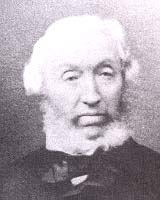Anthony Salvin
Anthony Salvin | |
|---|---|
 Anthony Salvin | |
| Born | 17 October 1799 |
| Died | 17 December 1881(aged 82) |
| Occupation | Architect |
| Known for | Tudor style architecture Restoration of castles,country housesand churches New houses and churches |
| Children | Osbert Salvin |
Anthony Salvin(17 October 1799 – 17 December 1881) was an Englisharchitect.He gained a reputation as an expert onmedievalbuildings and applied this expertise to his new buildings and his restorations. He restored castles andcountry houses,and built a number of new houses and churches.[1]
Early life and training[edit]
Anthony Salvin was born inSunderland Bridge, County Durham,as the only child of Anthony Salvin, a soldier, and his second wife Elizabeth (Eliza) Mills.[1]He was educated atDurham Schooland in 1820 became a pupil ofJohn Paterson[2]ofEdinburghwhile he was working on the restoration ofBrancepeth Castlein County Durham.
In 1821 Salvin moved toFinchleyin north London. He had an introduction to SirJohn Soanebut did not enter his office. According to his nephew, he entered the office ofJohn Nash.In 1824 he was elected as a fellow of theSociety of Antiquaries.Soon after this he went on a sketching tour of Great Britain. On 26 July 1826 he married his cousin, Anne Andrews Nesfield. With her he had six children, two of whom died in infancy.[1]
Early career[edit]
Salvin's first major commission wasMamhead HouseinDevonfor Robert William Newman. This was designed in theTudorstyle to a symmetrical plan. It was adapted from a plan byCharles Fowlerand this placed restrictions on his design. His next design was forMoreby Hallin theEast Riding of Yorkshirefor Henry Preston where he was free to develop a complete design in the Tudor style, again on a symmetrical plan.
AtScotney CastleinKenthe designed for Edward Hussey an asymmetrical design in the Tudor style. In 1831 Salvin embarked on what is considered to be his most important early domestic work atHarlaxton ManorinLincolnshirefor Gregory Gregory. Salvin's design combined elements fromMontacute HouseinSomersetandHengrave HallinSuffolk.However, before the building was complete, Salvin was replaced as architect byWilliam Burn.In 1835 Salvin spent five weeks in Germany.[1]
In 1836 Salvin entered a design in Tudor style in the competition for the newPalace of Westminsterwhich had possibly been inspired by his visit to Germany. However this was unsuccessful, as was his entry for the competition to design theAshmolean MuseuminOxford.He won the competition for the design of theCarlton ClubinPall Mall, London,but the club decided not to proceed with his plan. After losing a further competition, this time to design theArmy and Navy Club,Salvin did not enter any more competitions.[1]
Mature career[edit]

Most of Salvin's designs for major houses continued to be in the Tudor style. These includeKeele Hallin Staffordshire forRalph Sneyd (1793–1870),andThoresby Hallin Nottinghamshire forSydney Pierrepont, 3rd Earl Manvers.There were exceptions, includingPenoyre HouseinBrecon,anItalianatevilla-style house for ColonelJohn Lloyd Vaughan WatkinsandOxon HoathinWest Peckham,Kent in the FrenchChâteauesquestyle for Sir William Geary.[1]
A major part of Salvin's work was to restore, refit and create castles. In 1835 he refacedNorwich Castle,in 1844 he repaired the ruins ofNewark Castleand in 1845 he repaired the ruins ofCarisbrooke Castleon theIsle of Wight.In the early 1840s the Queen's Gate ofCaernarvon Castlecollapsed, and in 1844 Salvin repaired it and rebuilt some of the other masonry of the castle. He also restoredNaworth Castlein Cumbria after it was damaged by a fire on 18May 1844.[3]
In 1851 he surveyed the Beauchamp Tower of theTower of Londonand subsequently restored theSalt,Wakefield and White Towers and theChapel of St Peter ad Vincula.Following this he was instructed byPrince Albertto carry out work onWindsor Castle.This included replacingsash windowswithlancetsandmullionedwindows and rebuilding the Clewer Tower. Salvin designedPeckforton Castlein Cheshire forJohn Tollemache, 1st Baron Tollemacheas a recreation of a castle of the time ofEdward I.In 1852 he started work on the restoration ofAlnwick Castlein Northumberland. This included replacing one of the towers with a larger tower, the Prudhoe Tower, creating aporte-cochère,replacing windows and replanning the interior.[1]
Salvin also restored and repaired 20 old churches and three cathedrals, and built 34 new churches. In the early 1840s he had worked onThe Holy Sepulchre, Cambridge,employingJames Rattee,[4]and following this he was made an honorary member of theCambridge Camden Society.He arranged for the removal of buildings around the south transept ofNorwich Cathedraland reordered its choir. He also made alterations toDurhamandWells Cathedrals.[1]In all he designed at least 34 new churches. Salvin's restorations were not to the liking of theSociety for the Protection of Ancient Buildings,particularly his removal of "unwanted fabric" from churches.[1]Other work carried out by Salvin included rebuilding the keep ofDurham Castlefor student accommodation, and work on restoringTrinity College, Cambridge.[1]
Later life[edit]
In 1857, while working onWarwick Castle,Salvin suffered a stroke but recovered from it. In 1860, his wife died and he designed a new house for himself, Hawksfold atFernhurst,Sussex. In 1863 he was awarded the royal gold medal of theRoyal Institute of British Architectsand in 1879 he retired from formal practice. He died at Hawksfold in 1881 and was buried at Fernhurst. His estate was valued at over £78,000 (£8,370,000 in 2022).[5][1]
See also[edit]
- List of new churches by Anthony Salvin
- List of church restorations and alterations by Anthony Salvin
- List of work on castles and country houses by Anthony Salvin
- List of miscellaneous works by Anthony Salvin
References[edit]
- ^abcdefghijkHolder, Richard (2004)."Salvin, Anthony (1799–1881)".Oxford Dictionary of National Biography(online ed.). Oxford University Press.doi:10.1093/ref:odnb/24585.Retrieved3 July2013.(Subscription orUK public library membershiprequired.)
- ^"John Paterson: Biography".Dictionary of Scottish Architects.Retrieved27 March2024.
- ^"Naworth Castle".Bell's Weekly Messenger.16 July 1855.Retrieved17 November2015– viaBritish Newspaper Archive.
- ^Boase, G. C.;Marsden, Christopher (rev.) (2004)."Rattee, James (1820–1855)".In Marsden, Christopher (ed.).Oxford Dictionary of National Biography(online ed.). Oxford University Press.doi:10.1093/ref:odnb/23164.Retrieved3 July2013.(Subscription orUK public library membershiprequired.)
- ^UKRetail Price Indexinflation figures are based on data fromClark, Gregory (2017)."The Annual RPI and Average Earnings for Britain, 1209 to Present (New Series)".MeasuringWorth.Retrieved7 May2024.
Further reading[edit]
- Jill Allibone.Anthony Salvin: Pioneer of Gothic Revival Architecture,Cambridge: Lutterworth Press, 1988.ISBN978-0-71882-707-6
External links[edit]
| Archives at | ||||||
|---|---|---|---|---|---|---|
|
||||||
| How to use archival material |
